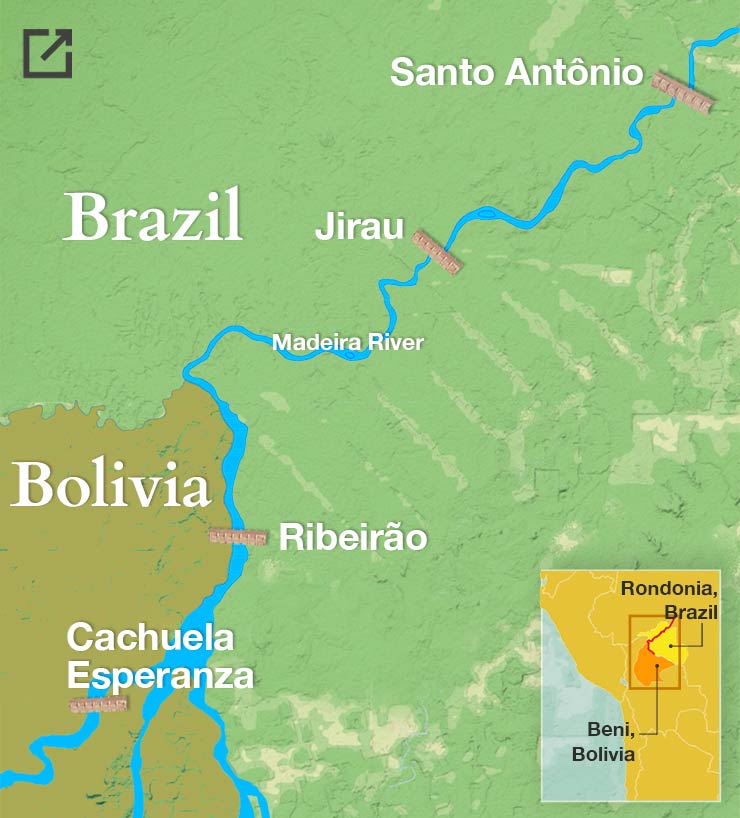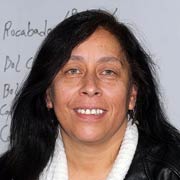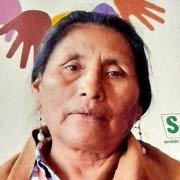The prodigious waters of the Madeira River basin are traveled by at least 1,000 species in addition to the bufeos -- a third of the fish species of the entire Amazon. Yet these waters are being eyed by the governments of Bolivia and Brazil whose vision is to harness the Madeira River’s murky waters for much-needed energy.
Since 2008, when construction of the Santo Antônio and Jirau dams began, the two countries have had a cooperative agreement to explore the possibility of new projects.
At the time, plans already included two projects: Ribeirão, a hydroelectric plant to be built between the border towns of Guayaramerín and Guajará-Mirim and Cachuela Esperanza, which would be built in the Bolivian territory of the same name. Both dams, along with Jirau and Santo Antônio, are part of the Madeira River hydroelectric complex, promoted by the Initiative for the Integration of Regional Infrastructure in South America (IIRSA).
In the case of Bolivia, this planning is part of the initiative "Bolivia, energy heart of South America", one of the main energy programs promoted by the government of former President Evo Morales. The initiative is part of the Patriotic Agenda 2025, which states that by that date, 95% of the Bolivian population will have electricity. About 3,000 (MW) of surplus electricity is expected to be exported to neighboring countries.
Indigenous communities, activists and scientists have filed numerous claims about the multiple environmental and social impacts this plan will have. But the federal government has turned a deaf ear. It plans a $25 billion investment to dam different rivers in the country by 2025 with the construction of a series of hydroelectric plants.

Ribeirão, a hydroelectric plant to be built between the border towns of Guayaramerín and Guajará-Mirim and Cachuela Esperanza
Recently elected Bolivian President Luis Arce and his government intend to continue the initiative started by former president Evo Morales.
The government says "the projects in progress and the new ones that will be undertaken for the production of electric energy guarantee the supply of the internal market and even the export of energy to countries in the region".
At the same time, "it is important to export electrical energy to our neighbors. We must multiply this initiative to make energy the third export branch for the Bicentennial (2025)," the government says.
After several efforts by both governments, the bi-national alliance between Bolivia's Empresa Nacional de Electricidad (ENDE) and Brazil's Electrobras concluded a bidding process in 2017 that selected Worley Parsons, an engineering company based in Rio de Janeiro, to conduct the Bi-national Hydroelectric Potential Studies of the Madeira River Basin, which were financed by the Development Bank for Latin America (CAF).
The alliance between the state-owned energy companies of both countries --Electrobras and ENDE -- will formalize their governments’ instructions and present the studies during the coming months, foreshadowing the construction of new dams on the Madeira River.
According to publicly available documents, studies of hydroelectric potential are not limited to the Madeira River, but also include its tributaries: Beni, Mamoré, Ribeirão, Yate, Negro and Lage – which underscores the importance of the debate on the impacts of the hydroelectric plants already built on the Madeira River.
Silvia Molina, a researcher at the Center for Studies on Labor and Agrarian Development (CEDLA), said “we are facing an issue of not only infringement of rights, but of violation of the rules of Bolivia, and violation of certain aspects of the Constitution, such as the role of the Amazon and sovereign decisions".

Molina indicated that the circumstances under which these studies are being conducted are not well known. When Molina, together with Bolivian and Brazilian organizations, tried to obtain information in 2018, the Brazilian justice system said it was blocked by a confidentiality agreement. In the case of Bolivia, the request for information that the researchers presented to the Legislative Assembly received no response.
Molina, a civil engineer with experience in transportation and energy infrastructure issues, is concluding a research project with CEDLA titled "CAF's role as planner in regional hydroelectric energy".
According to Molina, CAF's actions as a financing entity for the Study of Hydroelectric Potential violate a series of Bolivian norms related to social control and transparency in public management, as well as international regulations, in terms of the responsibility of these multilateral financial institutions in affecting human rights.
Molina explains that the most complicated issue at this moment is to open the study to public debate because it is not only an energy debate, but a debate on the Bolivian Amazon.
In addition, "we are giving a very strong focus to transparency, an issue that we see as a violation of rights, and the issue of the role of CAF in seeing development above the people.”
In the light of the pandemic, Worley Parsons has been asking community leaders and other local representatives to schedule virtual presentations of the project. This has put members of the Movement of People Affected by Dams (MAB) on alert. MAB is one of the most influential popular mobilizations in Brazil and has been present in Rondônia since the construction of Jirau and Santo Antônio.

Francisco Kelvin, MAB's coordinator in Rondônia, said the movement is advising communities not to accept invitations to hear presentations of the studies on new hydroelectric plants. For Kelvin, the virtual consultations cannot be considered public consultations since many of the affected communities will not be able to participate due to lack of internet access.
Lidia Antty, who is on the Committee for the Defense of Amazonian Life in the Madeira River Basin in the municipality of Guayaramerín, Beni, was also contacted by Worley Parsons.
Antty told us in a discouraged tone of voice that the company is contacting people through WhatsApp to present the study virtually.

“When we told them that we wanted an official letter, and not a cell phone message, they responded that they had not yet completed the study, so they don't want to give the exact information”.
In Kelvin's opinion, since 2014 there has been significant pressure from the business community to get the new dams off the drawing boards and under construciton.
The reason, he said, is the perception that without additional hydroelectric plants upstream, the flow of the Madeira River will not be predictable. In 2014, the largest floods ever recorded occurred around the Madeira River. Thousands of people were left homeless when riverside communities were destroyed by the force of the water released by the plants.
"Ribeirão and Cachuela Esperanza would allow for water control, it would be the perfect water box," says the activist, who points to the Jirau hydroelectric plant as the main beneficiary of this greater flow control.
We contacted Electrobras to request copies of the studies of hydroelectric potential to be submitted for public consultation, but the Brazilian state-owned company informed us that it does not provide studies that are still in progress.
And so, the pink river dolphins and the local people of Bolivia and Brazil are trapped by their governments’ ambitious plans for construction of hydroelectric plants that threaten to isolate them further and are just as insurmountable as the barriers imposed by the Madeira River dams.